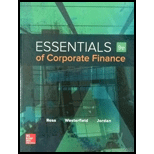
Concept explainers
Beta is often estimated by linear regression. A model often used is called the market model, which is:
Rt – Rft = αi + βi [RMt – Rft] + εt
In this regression, Rt is the return on the stock and Rft is the risk-free rate for the same period. RMt is the return on a stock market index such as the S&P 500 index, αi is the regression intercept, and βi is the slope (and the stock’s estimated beta). εt represents the residuals for the regression. What do you think is the motivation for this particular regression? The intercept, αi, is often called Jensen’s alpha. What does it measure? If an asset has a positive Jensen’s alpha, where would it plot with respect to the SML? What is the financial interpretation of the residuals in the regression?
Want to see the full answer?
Check out a sample textbook solution
Chapter 11 Solutions
Essentials of Corporate Finance (Mcgraw-hill/Irwin Series in Finance, Insurance, and Real Estate)
- in a Statistical sense, the Single Index Model is best characterized by: the Capital Market Line The Security Market Liner Regression of any asset as a linear function of the Market, plus mean-zero random error A regression of the Market, as a linear function of any given asset, plus mean-zero random error Iarrow_forwardWhen working with the CAPM, which of the following factors can be determined with the most precision? a. The beta coefficient of "the market," which is the same as the beta of an average stock. b. The beta coefficient, bi, of a relatively safe stock. c. The market risk premium (RPM). d. The most appropriate risk-free rate, rRF. e. The expected rate of return on the market, rM.arrow_forwardThe slope of a regression line when the return on an individual stock's returns are regressed on the return on the market portfolio, would be: OAR BR-₁ B OC none of the answers listed here. ODO imarrow_forward
- The Beta coefficients of TSLA and JPM are 1.99 and 1.18 respectively. What does Beta measure and how is it interpreted? Explain the beta values of TSLA and JPM by providing a calculated example of how they relate to market returns.arrow_forwardWhen working with the CAPM, which of the following factors can be determined with the most precision? a. The most appropriate risk-free rate, rRF. b. The market risk premium (RPM). c. The beta coefficient, bi, of a relatively safe stock. d. The expected rate of return on the market, rM. e. The beta coefficient of "the market," which is the same as the beta of an average stock.arrow_forwardAssume that using the Security Market Line(SML) the required rate of return(RA)on stock A is found to be halfof the required return (RB) on stock B. The risk-free rate (Rf) is one-fourthof the required return on A. Return on market portfolio is denoted by RM. Find the ratio of beta of A(βA) to beta of B(βB).arrow_forward
- The correlation with Market index, Beta and CAPM Req. Return worked out manually.arrow_forwardAssume that using the Security Market Line (SML) the required rate of return (RA) on stock A is found to be half of the required return (RB) on stock B. The risk-free rate (Rf) is one-fourth of the required return on A. Return on market portfolio is denoted by RM. Find the ratio of beta of A (bA) to beta of B (bB). please show all workings and not merely : Ra = 1/2 rbRf = 1/4 Raarrow_forwardAssume that using the Security Market Line the required rate of return (RA) on stock A is found to be half of the required return (RB) on stock B. The risk-free rate (Rf) is one-fourth of the required return on A. Return on the market portfolio is denoted by RM. Find the ratio of beta of A (bA) to beta of B (bB).arrow_forward
- Assume that using the Security Market Line(SML) the required rate of return(RA)on stock A is found to be half of the required return (RB) on stock B. The risk-free rate (Rf) is one-fourthof the required return on A. Return on market portfolio is denoted by RM. Find the ratio of beta of A(A) to beta of B(B).arrow_forward3. Suppose the index model for stocks A and B is estimated with the following results:rA = 2% + 0.8RM + eA, rB = 2% + 1.2RM + eB , σM = 20%, and RM = rM − rf . The regressionR2 of stocks A and B is 0.40 and 0.30, respectively. Answer the following questions. (a) What is the variance of each stock? (b) What is the firm-specific risk of each stock? (c) What is the covariance between the two stocks?arrow_forwardSuppose the index model for stocks A and B is estimated with the following results: rA = 2% + 0.8RM + eA, rB = 2% + 1.2RM + eB, σM = 20%, and RM = rM − rf . The regression R2 of stocks A and B is 0.40 and 0.30, respectively. Answer the following questions. Total: (a) What is the variance of each stock? (b) What is the firm-specific risk of each stock? (c) What is the covariance between the two stocks?arrow_forward
 Intermediate Financial Management (MindTap Course...FinanceISBN:9781337395083Author:Eugene F. Brigham, Phillip R. DavesPublisher:Cengage Learning
Intermediate Financial Management (MindTap Course...FinanceISBN:9781337395083Author:Eugene F. Brigham, Phillip R. DavesPublisher:Cengage Learning
